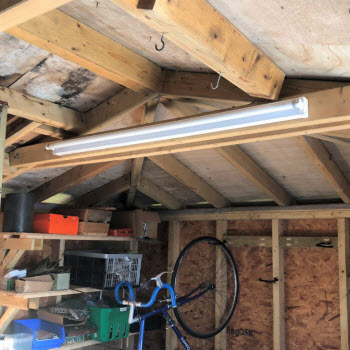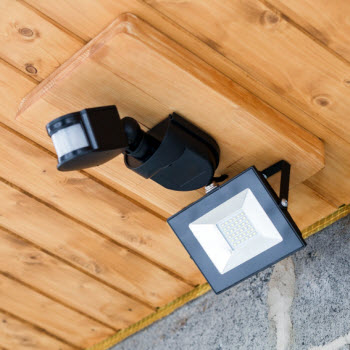25 Shed Lighting Ideas to brighten up your space inside and out
Whether you're looking for Shed Lighting Ideas to brighten up the space inside your shed or ideas for adding outside lighting to make it easy to find the way to your shed at night time, we've got you covered. From simple solutions like solar lights to more creative ideas like using string lights, these 25 Shed Lighting Ideas are sure to inspire you. So, get ready to shed some light on your project!

I have learnt a few things in my time building and repairing sheds. The main thing is that everyone of my customers is different and uses their shed in a different way, from storage to workshop to playhouse.
One customer may be happy with a single light in their shed so that they can easily find their power tools without tripping over the lawn mower. Whereas another person may require multiple lighting systems to cover a variety of needs inside and outside the shed.
So rather than try to describe lots of potential shed lighting projects I have come up with this list of 25 shed lighting solutions to get you started. I have broken them down into the following different areas to help:
- Natural lighting
- Power sources for shed lighting
- Solar shed lighting
- Types of lightbulb
- Interior shed lighting
- Outdoor lighting
- Shed lighting controls
Natural lighting
One of the best sources of light for sheds is natural light. Windows and skylights are a great way to bring in natural light, which can help reduce energy costs. If your shed doesn't have any windows or skylights, consider adding them.

1. Windows - are the best way to increase the amount of natural light in your shed. Most sheds have at least one window. The size of the window and the wall of the shed that you choose to have it on will affect the amount of light that it will let in. Windows high up on a wall at eaves level will let in some light without consuming too much valuable wall space.
2. Skylights - I love the idea of shed skylights. They hugely increase the amount of light in a shed without consuming wall space. Tips for improving a skylight are to put it on a north facing roof slope so that you get more cool, indirect sunlight than if it was placed on a south facing roof slope.
My only concern with skylights is that they are a potential source of water leakage.
3. Doors - Rather than have a solid door use a door with a window pane or even a patio type doors with a large pane of glass. Combining the functions of a door in this way will increase the amount of light in your shed.
Power sources for shed lighting

4. Mains electricity - The most common type of power source for shed lighting. Wiring to a shed will comprise installing an armoured cable as a spur from the consumer unit in the main dwelling. A separate 'fuse board' will be required in the shed itself from which to run the electrical wiring.
A suitably qualified electrician should always be employed for mains electrical work, remember to retain any certification that they supply which will be needed if you decide to move house.
Your electrician should advise you as to the size of cable required and type of consumer unit. Make sure that you have a thorough discussion with your electrician beforehand to make sure that they make provision for enough power for your lighting system as well as any other electrical power requirements.
How to light a shed without mains electricity?
5. Rechargeable batteries - If you don't have access to mains electricity, you can use battery powered lights. These don't have to be low powered affairs. You can set up a small diy 12V system in your shed without the requirement for employing an electrician. A low voltage system such as this is less hazardous than mains electricity if you make a mistake!
For this you can use leisure batteries that you charge up from your mains power source in the house.
6. Solar power - Another increasingly attractive option is solar-powered shed lighting. Solar shed lighting is now a good way to avoid the cost of hiring an electrician to install lights in your shed, a small solar system can even have enough power left over to charge batteries and power other electrical devices. See next three points...
Solar shed lighting
Solar energy is a great way to power your shed lights without having to worry about wires or plugs. There are a few different types of solar shed lighting to choose from, so you can find the right one for your needs.
7. Integral solar shed lights - These are the most basic system and comprise a light with built in panel and battery. During the day the solar panel charges the battery and as the daylight fades a sensor kicks in to switch the light on. This type of light can be great to have by the side of your shed door to provide light to get in on dark evenings.

What size solar panels do I need for a shed?
8. Solar power shed lights with separate solar panel - One of the most popular types of solar shed lighting is solar powered lights. This type of simple solar system will comprise a solar panel, regulator and battery. A basic system providing lighting and occsional power would have a 32 Watt solar panel, a 20 Amp regulator and 100 amphour battery.
The solar cells can be mounted on the shed's roof or a wall facing the prevailing sun. The cells top up the batteries when there is sufficient sunlight. You can then use the power for a 12V DC lighting circuit in your shed , which you operate with a normal light switch and powering any sort of electric lighting you desire. (more on these below…)
9. Solar lighting system - If you're looking for something with a little more Oomph, then consider investing in a more powerful solar energy system which will provide power for other items as well as lighting. A well designed system with enough reserves to see you through cloudy days and the less sunny winter months should probably have 200 Watt panels, a 40 Amp regulator and have a 2-400 Amp hour battery.

Types of light bulb

When it comes to shed lighting, there are a few different types of lightbulbs to choose from:
10. Incandescent bulbs - Were the most common type of light bulb for many years. however, they consume more energy than other types of bulb and so are generally being phased out for other more energy efficient light sources. In the UK it is difficult to find incandescent bulbs, but in the US they are still available, for the moment
The current advantage is that they are cheap to buy. However this initial low price is more than consumed by the greater energy requirements in their lifetime. As well as this they are hot to the touch. Probably best to avoid.
11. Fluorescent lights / strip lights - I have a personal interest in this type of lighting as I use them in my shed/workshop. The length of the bulbs, these are 3ft long, means that they give a good distribution of light. They do flicker when you switch them on and sometimes they hum a bit. They used to be the best form of workshop light but as with most things the LED lights are starting to give them a run for their money.

12. LED lights - This type of bulb is becoming the new standard, due to their energy efficiency, long lifespan and increasingly large range of formats. They can be a bit more expensive to buy initially than other types of electric lights, but they'll save you money in the long run due to their greater energy efficiency.
We used to compare lights based on the energy to run them ie 40W light bulb. However an led light uses much less power and so lights tend to be measured more on their light output, measured in lumens. For example in the picture below the bulb emits light equivalent to 470 lumens. An an old incandescent bulb would have consumed 40W of power, whereas this LED bulb requires just 4W, a huge saving! And the bulb will last much longer than the old style of bulb.

The type of led shed light that you choose will depend on the type of interior shed lighting that want. The bulbs vary from the very utilitarian to sophisticated mood lighting that changes color depending on your needs.
13. Daylight bulbs - Daylight bulbs are a special form of bulb that emit light frequencies that simulate natural light. If you spend time in your shed working at a desk in the winter a light of this type may help to reduce depression and other conditions related to lower light levels in the winter months.
Interior shed lighting
Now we move into various types of light fittings that you can you inside your shed for different functions and atmospheres. You might need something extremely utilitarian for occasional use or a sophisticated set up that can change light levels and color to your exact need.
14. Ceiling lights - In many ways the best place for a light is the ceiling. Located up high and central to the room it can give a good distribution of light. The location of a ceiling light is key. Having a light directly over a work bench where it casts plenty of light on what you are doing is much better than having it behind for example, where it would cast a shadow on your work.
15. Wall lights - are good for creating varying atmospheres. Wall lights can be in various forms. Uplighters, downlights or lanterns. The effect is very much influenced by the colour of the walls, the direction the light is directed and any shadows that are created.
16. Mood lighting - Moving on from atmospheres created by wall lights, mood lighting can have different colors. These LED bulbs have green red and blue diodes in the same unit. The bulbs can mix these in different proportions to create almost any light color. This sort of thing is great in a she shed or man cave where all sorts of different work or social atmospheres can be created.
17. Inspection lamp - Having a corded inspection lamp for working in specific areas is really useful if the work area. Traditionally this would have been a corded bulb with a protective cage around the bulb. More likely these days it will be a cordless led unit that can stand alone or be suspended from a convenient point. These rechargeable work lamps either have integral batteries or work with the battery packs that power common power tools.

18. Table lamp - Once again this type of light comes in a huge number of variations. It could be a simple lamp stand with a shade. Or the directional angle poise lamp, this type of work lamp is very controllable in the amount of light and direction that it is cast on to the work or task at hand.
Outdoor lighting

19. Floodlights - Outdoor security lights are probably the most commonly used form. Many have an integral motion and light sensor, so that when they are triggered by movement after dark the whole area is lit up. Increasingly floodlights are LED lights, for power reasons. When installing this type of light a fair amount of trial and error is required to get the sensor triggering at the right level and not just by every passing fox. Also, the direction of the floodlight is important so as not to inadvertently annoy your neighbours.
But outdoor flood lights can be so much more than just for security, highlighting areas of your garden such as plants or sculpture for dramatic effect.
20. Fairy lights - If you are looking to create a nice atmosphere then a string of fairy lights can do just that. They can be scattered in an apparently random fashion for twinkles or used to highlight the edge of a sign or shape.
21. String lights - These bulbs are relatively large and good for light coverage as well as creating a party atmosphere. The bulb colours can be varied too, for a more Christmassy look.

Lighting controls
Using different forms of light switch to control your shed lights can transform the way that use your shed. A very quick example would be to change a normal wall switch for a switch operated by a pull cord, so that it is easier to operate if you have your hand full.
22. Dimmer switch - Controlling the amount of light emitted is a good way of varying the atmosphere in your shed. Make sure that the bulbs you purchase are described as dimmable, as not all LED have this possibility.
23. Remote control - Does the garden look dark and spooky? Having a remote control or even a switch in the house to light the pathway to the shed can make the trip less intimidating. With the wide range of switches on the market now you can even turn your shed lights on and off using your mobile phone.
24. Motion sensor - I mentioned this earlier with respect to floodlighting. Motion sensors can be incorporated within your shed to turn on lights when you go in or to sense when an intruder has gone into your shed (and also to alert you via your mobile phone)
25. Timer - Perhaps one of the most basic controls of all. Having the lights turn off at a specific time, to a specific schedule might be helpful to visitors. The traditional form was a plug that had various sectors to turn on and off but now these are programmable via your mobile phone.
Conclusion
Shed lighting can really make a difference in the overall look and feel of your shed. These 25 ideas should give you a good starting point for creating the perfect lighted space for your needs.
Shed lighting doesn't have to be an afterthought - it can add just the right touch of personality and function to your shed.
Have fun with it and be creative!

Keep in touch with our monthly newsletter
Shed Building Monthly




